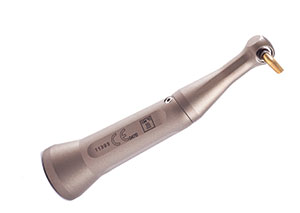I am often asked by patients and other dentists “How did you do that so painlessly?” or “What do you mean you are done?” and my typical response is that it was magic performed by the great Goldini. Although this often works for a good laugh, the reality is that I am not Houdini, arguably the greatest magician of all time, but simply a general dentist that has extracted thousands of bad teeth over the last 40 years employing unconventional methods.
As a dentist reading the title to this article, you may be thinking to yourself one or more of the following thoughts:
- I do not have an issue with the way I currently extract teeth;
- I typically refer out all and/or difficult extractions;
- I wish I was more comfortable with extractions in general;
- I wish my extractions were more predictable; or
- I wish I could increase my overall bottom line by not referring out extractions and losing patients.
No matter what you, the dentist may be thinking, exodontias of any tooth (except impacted third molars), in any condition, can be simple, predictable and extremely efficient if you are willing to think about exodontias in a manner unlike anything you have been taught through your formal education. I do not care if you graduated from dental school this year or forty years ago, the methods of performing and teaching exodontias have been relatively unchanged in more than 200 years until very recently.
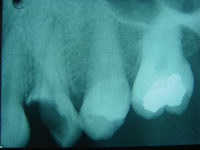 |
 |
|
Figure 1. Broken crown, little to grasp onto with conventional forceps. Tooth No. 5. |
Figure 2. Large cavity, difficult to grasp with conventional forceps. |
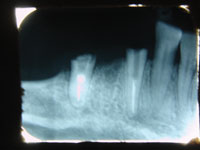 |
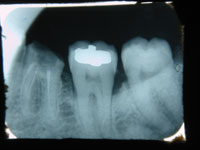 |
|
Figure 3. No crown to grasp onto with conventional forceps. |
Figure 4. Endodontically treated with no crown. |
What if I told you in general, that any tooth, in any condition (Figures 1 to 4), by any general dentist, can be performed in less than 4 minutes using only wrist movement?
Would you believe me, or at least be willing to consider a new unconventional technique of extracting teeth.
What is All the Hype With Atraumatic and/or Predictable Extractions?
Let’s face it, the economy has not been great over the last couple years and this has taken a toll on many practices. In my hometown of Detroit, many autoworkers have lost their healthcare due to unemployment, which means paying out of pocket for all dental care and putting off any dental work that is absolutely not 100% necessary. The free dental clinics that I volunteer at are overwhelmed with patients needing dental care at alarming numbers. This is a scary situation and dentists are looking more and more to expand their service offerings to avoid losing the paying patients that are coming into their office. Not only are we, as dentists, looking to increase our service offerings, we are looking to do them more efficiently. This is evident in dental magazine advertisements and at trade shows where you will see a mixed bag of courses entitled strategies to increase your bottom line, learn how to be more efficient and profitable, to name a few of the many. This is very telling of the economic environment we are operating in—we must adapt or potentially fail since in this business, time is money.
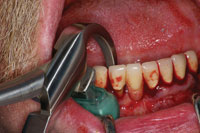 |
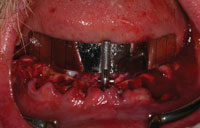 |
|
Figure 5. Before: Physics Forceps lower universal. (Courtesy of Ara Nazarian, DDS) |
Figure 6. After: preparation for implant placement (Courtesy of Ara Nazarian, DDS) |
In addition to the economic factor noted above, another area that has greatly increased the interest in atraumatic extractions over the last decade relates to implants. Atraumatic tooth extractions are desired more and more to preserve bone for immediate implant placement. Also, in connection with the economic factor noted above, implants can be a very profitable procedure, especially when performed in conjunction with full mouth extractions (Figures 5 and 6).
As a result, more dentists are now placing implants or have a desire to learn how to place implants.
With this said, it’s time for general dentists to become specialists in exodontias.
There is a Better Way
Traditional forceps may not be effective, but if you equate traditional extraction techniques to other common life events such as removing a nail embedded securely in a piece of wood or opening a nonscrew off cap from a bottle, you would never approach these events in the same manner. For example, when removing a nail, would you use pliers or would you use a hammer (Figures 7 and 8)?
Similarly, while enjoying yourself at a social gathering would you use pliers to grasp a bottle cap and pull it off, or would you look for a bottle opener (Figures 9 and 10)?
This is far from a novel concept, but it you think about it, traditional forceps are like the pliers in the examples above and clearly do not make sense in these situations. So why have dentists been approaching exodontias in this manner for hundreds of years? Good question, right? The answer is simple—this is how I was educated and the instruments available did not provide for alternatives.
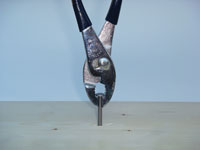 |
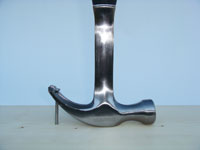 |
| Figures 7 and 8. Demonstrating benefits of leverage: removing nail with hammer is much easier than with pliers. |
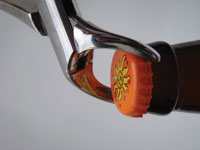 |
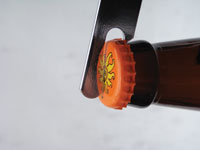 |
|
Figures 9 and 10. Demonstrating benefits of leverage: removing a bottle top with a bottle opener is easier than grasping with pliers and trying to pull off cap. |
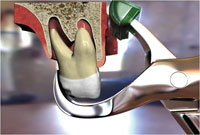 |
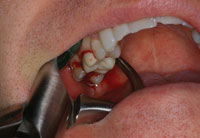 |
| Figure 11. Beak placement on tooth (animation). |
Figure 12. Beak placement on tooth. (Courtesy of Ara Nazarian, DDS) |
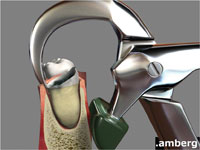 |
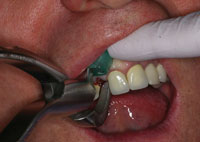 |
|
Figure 13. Beak placement on root (animation). |
Figure 14. Beak placement on root. (Courtesy of Ara Nazarian, DDS) |
Conventional exodontias requires 2 equal forces applied on the tooth (squeezing) combined with a third force, which is the movement of your arm, to release the tooth from its socket. This is something we, as dentists, are all aware of and were taught in school, so I will not elaborate on the background of conventional exodontias in this article. What I would like to focus on is what if instead, one force is applied (without squeezing) and the need for pulling with your arm was replaced with only slight wrist movement, which is what happens when the mechanical advantage of a first class lever is utilized.
It’s All in the Wrist—Let’s Get Predictable
The Physics Forceps (Golden Dental Solutions, formerly known as GoldenMisch) have a revolutionary beak and bumper design that allows for efficient atraumatic extractions using only wrist movement based on a Class I lever. The Physics Forceps technique eliminates the need to firmly grasp, twist, rock, push and pull with your arm. When this technique is first attempted, a conscious effort must be made to retrain your hands to not squeeze the instruments and to not pull with your arm. This can be the largest barrier to break through and be successful with this technique, but once this barrier is broken the advantages of the Physics Forceps are unlimited. In my profession, I talk to many dentists each week either on the phone, through email or at lectures, where I find that many dentists get the technique on the first or second try and have great success immediately.
The Physics Forceps act simply like a class I lever, where only one force is applied with the beak on the lingual aspect of the tooth (Figures 11 and 12) or root (Figures 13 and 14). Once the beak is placed, the bumper is placed on the alveolar ridge at the approximate location of the mucogingival junction to balance the beak. The beak grasps the tooth, while the bumper is the fulcrum to provide leverage and stability for the beak and wrist movement.
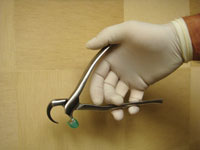 |
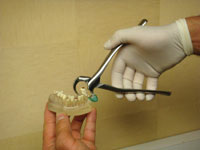 |
|
Figures 15 and 16. Two suggested hand positions—lower universal. |
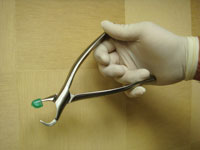 |
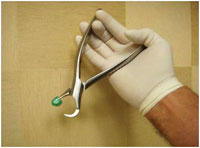 |
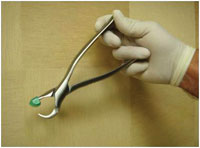 |
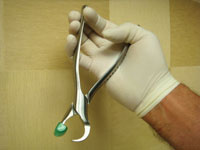 |
|
Figures 17 to 20. Four suggested hand positions—upper left and right. |
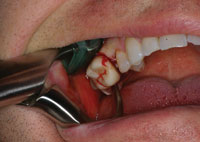 |
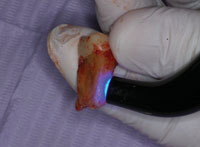 |
|
Figure 21. Rotational force using wrist only. (Courtesy of Ara Nazarian, DDS) |
Figure 22. Tooth and root—tooth had vertical fracture and was removed with physics forceps. (Courtesy of Ara Nazarian, DDS) |
Once the instrument is properly placed, your hands (or fingers) should be loosely placed toward the end of the handles to obtain maximum leverage. This may be simply 2 fingers or any similar position where the instrument feels comfortable in your hand as long as you are not squeezing the handles (Figures 15 through 20).
Once the instrument is properly placed, pressure is slowly applied using only wrist movement, using only wrist movement, using only wrist movement—yes, I am aware I said this 3 times since it is very important that there is no squeezing of the handles. I cannot emphasize this point enough. If you squeeze or move your arm you will fail (Figure 21).
Apply a steady and gentle pressure toward the buccal with only your wrist. During this holding period, you may be sitting there asking yourself should I be doing something else or am I doing this correctly and before you know it in a matter of seconds (approximately 30 seconds to a minute) the internal force or “creep” will build up allowing the bone to slowly expand and the periodontal ligament to release at which point the tooth will disengage from its socket (knows as the “pop”). The buccal only rotation of the tooth is only successful by rotating your wrist, very similar to the bottle opener example above, but in reverse.
Once the tooth has disengaged from the socket, stop. The instrument has completed its task and another instrument of choice (eg, rongeurs) or your fingers can be utilized to remove the tooth (Figure 22).
The mechanical advantage created by the Physics Forceps makes them a very efficient set of instruments, where if used properly will surprise you at just how simple and predictable extractions can be performed.
Some of the many advantages of utilizing this technique and the Physics Forceps include:
- Predictable and efficient extractions typically in less than 4 minutes;
- Preserving the buccal bone and cortical plate;
- Preventing having to lay flaps and removing bone to access roots;
- Virtually eliminating root tip fractures;
- Increasing services available to your patients so you do not need to refer them out;
- Increasing patient referrals based on atraumatic tooth extraction;
- Increasing your bottom line by eliminating referrals;
- Assisting with efficient full mouth reconstructive extractions; and
- Supporting immediate implant placement as now being taught in many dental implant courses.
What About the Buccal Bone?
If this technique is performed properly it will not cause buccal bone damage.
It is generally understood in our profession that the physical change of expanding the dental alveolar bone (socket) along with the severing of the periodontal ligament is the basis of tooth extraction. Although this does happen, it is more important to understand what is occurring biochemically with the tooth and its socket. When the periodontal ligament is traumatized with forceps or elevators, hyaluronidase (hyluronate glycanohydrolase) is released. This is an enzyme that catalyzes the hydrolysis of the interstitial barrier, hyaluronan (hyaluronic acid), which is the cement substance (extracellular matrix) of all human tissue. The tooth is released from its attachment to the alveolus and can be removed, once chemical breakdown of the periodontal ligament by hyaluronidase occurs.
The technique described in this article applies a steady rotational trauma to the periodontal ligament quantitatively creating a release of hyaluronidase in a shorter period of time than traditional forceps or elevator extractions because the trauma from these conventional techniques is intermittent (ie, not a steady constant force). As a result, the Physics Forceps technique is more efficient, faster, and less traumatic to the alveolar bone than conventional methods.1,2
Having alveolar bone come out with the tooth can be caused by several things. First of all, proper placement of the beak as subgingival as possible, and apical placement of the bumper to ensure an arc of rotation allowing the tooth to move occlusally when it is first disengaged from the socket, is critical. If it is not completely a wrist rotation this can also lead to alveolar fracture. And of course squeezing the handles can also cause this problem.
Become an Everyday “Houdini”
We refer nowadays to people who escape from impossible situations as “Houdinis.” I encourage you to learn more about the technique discussed in this article by visiting the Web site physicsforceps.com. It is time to add a little magic to your practice by performing extractions you once viewed as impossible on a routine basis in less than 4 minutes. You may be surprised at just how easy difficult extractions can be performed.
References
- Abrahamsen, TC. Biochemistry of Tooth Extractions. physicsforceps.com/features.html. Accessed April 21, 2011.
- Frasher JR, Laurent TC, Laurent UB. Hyaluronan: its nature, distribution, functions and turnover. J Intern Med. July 1997;242: 27-33.
Dr. Golden graduated from the University of Detroit Mercy School of Dentistry in 1971, and he currently serves as a board of directors for the University. He is a general dentist with a private practice in Detroit, Mich. His strong business background prompted him to be the first general dentist in Michigan to advertise, open multiple offices, offer a 5-year guarantee, and to provide general anesthesia. His most notable breakthrough was the discovery of applying the power and predictability of controlled leverage to the extraction procedure. This resulted in the development of the Physics Forceps extraction instruments. He can be reached at (877) 987-2284 or at info@goldendentalsolutions.com.
Disclosure: Dr. Golden is President of Golden Dental Solutions.






